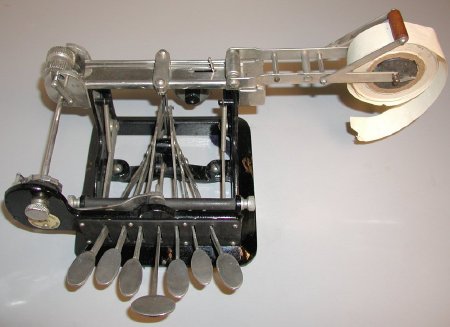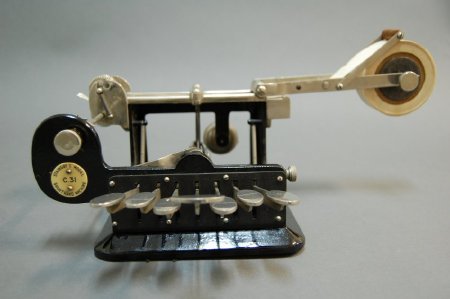Object ID:
2005.40.4
Title:
Stainsby "C" Braille Shorthand Writer
Creator:
Stainsby, Henry
Description:
(a) writer: black enameled cast brass frame; seven nickel plated keys with middle key arranged parallel and the remaining six perpendicular to frame; hard rubber pad above key arms; round celloloid label screwed at left, "C41"; folding paper tape arm on right with wooden roller on separate hinged arm; carriage end bell on back right of frame with striking arm; thumbscrew on left locks geared tape advancing rollers; upward writing styli concealed beneath bar housing on top of the grooved paper guide; (b) case: box-jointed wooden case, covered with black faux leatherette with steel reinforced leather carrying handle on right side of box; lid is hinged in two places, secured with thumbcatches on sides, bars on back hold lid in open position; interior lined with green felt; footprint recess in bottom for writer and two turning steel brackets; stamped on lid catches, "TUCKTITE/PAT.234004-24/ENG. MAKE".
Dimensions:
H-7 W-10.5 D-12 inches
Date:
ca. 1930
Made by:
Birmingham, England
Place of Origin:
Birmingham, England
Provenance:
Henry Stainsby (1859-1925), Supt. of the Birmingham Royal Institution for the Blind, along with Birmingham manufacturer Albert Wayne patented a braille shorthand machine in 1899-1900. His tapewriter was developed as a note-taking tool for blind stenographers being trained at Birmingham. Stainsby's goal was employment for his students. By the 1920s, the Stainsby-Wayne Braille Shorthand Writer was being sold by the National Institute for the Blind. In 1928, this version was introduced, touted as "reduced in size, weight, and cost." It was replaced by 1933 by the Model D. This writer belonged to the Louisiana Instructional Materials Center for the Blind and Visually Impaired at the Louisiana School for the Visually Impaired, founded in 1852.
Credit Line:
Gift of the Louisiana Instructional Materials Center for the Blind and Visually Impaired, 2005.40

